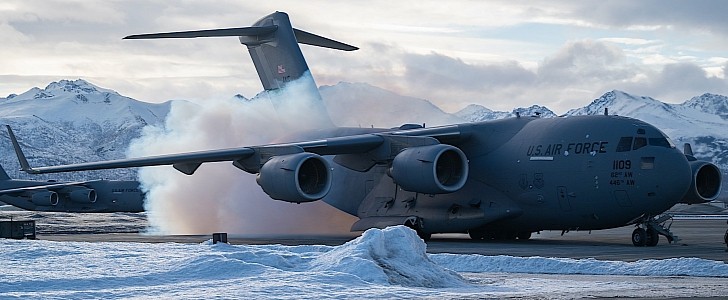Back at the beginning of February, the U.S. Air Force treated us with a photo of a C-17 Globemaster III engulfed in smoke. The stuff was not generated by some fire onboard, but by the excess preservation oil being heated after a long storage period, once the engines were started.
Given how dealing with real-life C-17 Globemaster IIIs is not something we usually do, we don’t really have a clear picture of how messy the business of starting the engines of this behemoth is. Turns out it’s very messy, at least in terms of smoke generated, and not only after long periods in storage, but also during a cold start of the thing’s four Pratt & Whitney engines.
A taste of that can be seen in the photo we have here, taken at the end of March at Joint Base Elmendorf-Richardson in Alaska, and recently made public by the USAF.
The Globemaster, assigned to Joint Base Lewis-McChord in Washington, was on the runway, ready to partake in Exercise Rainier War 22A. The crew who operates it cold-started the engines, generating the impressive amount of white smoke billowing out the back.
The plane is part of the same unit we talked about last week, the 62nd Airlift Wing, which was present in Alaska to demonstrate its ability to “operate and survive while defeating challenges to the U.S. military advantage in all operating domains – air, land, sea and cyberspace.”
As for what a cold start is for an airplane engine, that means turning it on after a long period of inactivity, but also when the temperature outside is below 20 degrees Fahrenheit (minus 6.6 degrees Celsius). Generally, bringing the engines to optimum operating temperature requires an increase in power in stages, which on average, and for a regular-sized airliner, can take up to 15 minutes.
A taste of that can be seen in the photo we have here, taken at the end of March at Joint Base Elmendorf-Richardson in Alaska, and recently made public by the USAF.
The Globemaster, assigned to Joint Base Lewis-McChord in Washington, was on the runway, ready to partake in Exercise Rainier War 22A. The crew who operates it cold-started the engines, generating the impressive amount of white smoke billowing out the back.
The plane is part of the same unit we talked about last week, the 62nd Airlift Wing, which was present in Alaska to demonstrate its ability to “operate and survive while defeating challenges to the U.S. military advantage in all operating domains – air, land, sea and cyberspace.”
As for what a cold start is for an airplane engine, that means turning it on after a long period of inactivity, but also when the temperature outside is below 20 degrees Fahrenheit (minus 6.6 degrees Celsius). Generally, bringing the engines to optimum operating temperature requires an increase in power in stages, which on average, and for a regular-sized airliner, can take up to 15 minutes.







